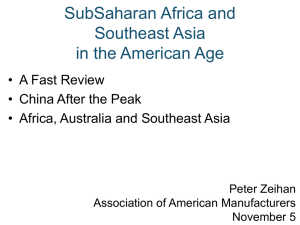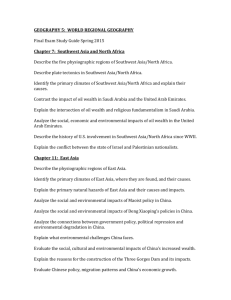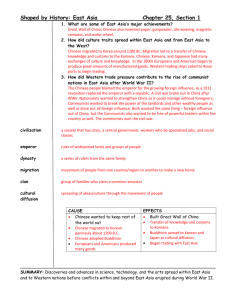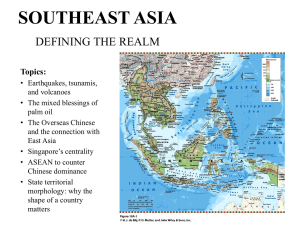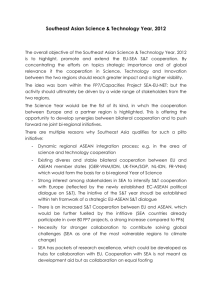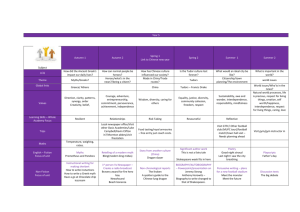Southeast Asia - Brett's Geography Portal
advertisement
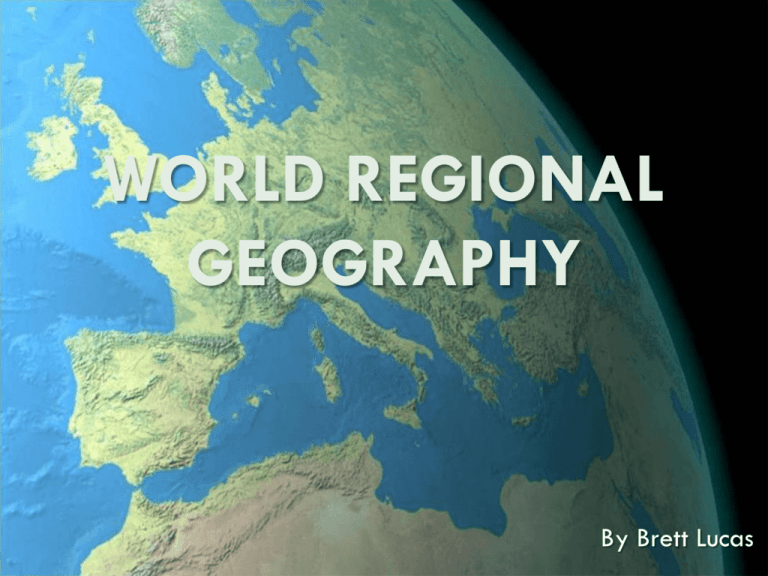
WORLD REGIONAL GEOGRAPHY By Brett Lucas SOUTHEAST ASIA – Part 1 Defining the Realm A Geographic Overview Mainland and Insular physiographies Realm’s Giant: Indonesia Size of area and population Borders of the realm: India and China: source of immigrants, cultural infusion, economic interaction, and more Concept Caching: Geography Textbooks and Atlases, Malang, Indonesia Southeast Asia’s Physical Geography Part of the Pacific Ring of Fire: 2004 undersea earthquake and tsunami of Indian Ocean. Volcanic eruptions: some have provided a better understanding of the complex climate system. High relief realm dominates on both on mainland and insular regions. Southeast Asia’s Physical Geography: Exceptional Borneo “Mini-continent” amid a mass of volcanic activity: No volcanoes and negligible tremors Slab of ancient crust uplifted above sea level and subsequently eroded Ecosystems: Equatorial rainforests once a sanctuary to countless plant and animal species Today, much destroyed by logging, roads, and farms Palm-Oil Plantations and Deforestation Versatile palm oil Today, very lucrative agricultural crop High yields and demand Rising prices Plantation expansion single largest threat to tropical forests and habitat Pressures for sustainability Concept Caching: Indonesia's Fertile Countryside Southeast Asia’s Physical Geography: Relative Location and Biodiversity Destination for migrating species: Animal and human migrations during shifting climactic periods or new modes of transportation Know for its biodiversity: estimates that 10% of world’s plant and animals species are found there Shifting Cultivation Shifting cultivation is also known as slash and burn or swidden cultivation To maintain soil fertility in these warm wet environments, farmers move their fields every 3 years or so, letting old plots lie fallow for 15 years or more The regrowth of forest on once-cleared fields not only regenerates the soil, it also absorbs significant amounts of carbon dioxide from the atmosphere Southeast Asia’s Physical Geography: Four Major Rivers Lots of moisture Population distribution highlights relationship between people and rivers: Not just for water and agriculture Also as transportation arteries Coastal clusters at river deltas Southeast Asia’s Physical Geography: Four Major Rivers The Mighty Mekong Source in China’s Tibetan Plateau Borders five of the realm’s countries Supports farm and fishing livelihoods Upstream politics: China’s dam projects Managing flow volumes Intra-realm development projects Southeast Asia’s Physical Geography: Four Major Rivers Rivers and States Other rivers in the realm are local: Red River of Vietnam and its capital Hanoi Chao Phraya River in Thailand and its capital, Bangkok Irrawaddy River in Myanmar with its largest city, Yangon, sitting on the delta Population Geography Indonesia’s noteworthy Javan population cluster: More than half the country’s population Fertile volcanic soils, ample water and warmth Other clusters are fastgrowing urban areas. Concept Caching: Java, Indonesia Population Geography: The Ethnic Mosaic Common stock with local ethnic/cultural groups Mainland spatial coincidence: major ethnic groups and political states Island nations ethnic groups In both, minorities present in remote peripheries: Uplands forests or dense Population Geography: Immigrants Some major ethnic minorities come from outside the realm South Asian peoples: Some during European colonial period Others from early Buddhist migrations Population Dynamics All countries are nearing the last stage of the demographic transition, where births and deaths are low and growth is miniscule or slightly negative. Between one-quarter and one-third of the people are aged 15 years or younger. Brunei, Singapore, and Thailand have reduced their fertility rates; as a result, they will be coping with aging and shrinking populations. Population Geography: The Chinese Long history of migration out of China Overseas Chinese concentration in cities Chinatowns Today the realm has more than half the world total: Tensions with local ethnic majorities Regional Issue: The Chinese Presence in Southeast Asia THE CHINESE ARE TOO INFLUENTIAL! Chinese were given privilege and separateness. Chinese act on their own behalf, not as part of the country that they live and work in. Chinese exploit Southeast Asian opportunities and shared resources. THE CHINESE ARE INDISPENSIBLE! All minorities have troubles. Others are resentful of Chinese resourcefulness and success. Chinese aloofness depends on the state context. Chinese have made great contributions. Religions of Southeast Asia Historic crossroads of religions: Hinduism and Buddhism from South Asia Islam from Southwest Asia Leads to great cultural diversity: Different countries trend toward one religious system, yet presence of other significant religious groups Much cultural expression has been through infusion of foreign elements Concept Caching: Hindu Balinese dancers of Ubud, Indonesia Colonialism’s Heritage: How the Political Map Evolved Europeans arrived to a politically fragmented realm: Mainland river basins and plains as well as the islands produced a cultural diversity of societies. European colonization involved “divide and rule:” Out of that strategy they forged comparatively large, multicultural states. Foreign intervention created the contemporary political map. Colonialism’s Heritage: How the Political Map Evolved: The Colonial Imprint French Indochina • • Southeast Asian empire called Indochina. Indo- referred to South Asian cultural imprints. Five French dependencies into three political states: Vietnam Laos Cambodia Colonialism’s Heritage: How the Political Map Evolved: The Colonial Imprint British Imperialism • • Burma: part of the South Asian British Empire: ─ Not part of South Asian religious-borne partition Malaya: system of colonies and protectorates: ─ Malaya refers to the geographic area of the Malaysian peninsula. ─ Eventually became complex Malaysian Federation. Colonialism’s Heritage: How the Political Map Evolved: The Colonial Imprint Netherlands “East Indies” “Spice Islands”: Name came from lucrative spice commerce between Arab, Indian, and Chinese traders. Europeans’ great lengths to control the trade: Spices to conserve food and add flavor Very high demand, and thus very lucrative in Europe Jawa: the focus of Dutch colonial administration: Dutch East India Company and the Dutch government extended influence over the smaller islands over time. Colonialism paved the way for creation of realm’s largest state. Colonialism’s Heritage: How the Political Map Evolved: The Colonial Imprint From Spain to the United States Spanish control of the Philippines: Spread Catholicism and stave off Islamic incursions in the south Manila: a profitable way-station in travel across the Pacific Spanish-American war: Already the Spanish were facing indigenous uprising. Spain forced to settle following the brief war: Ceded the Philippines to the United States Local revolt for a time, but ultimately unsuccessful Southeast Asia’s Emerging Markets: Singapore’s Centrality Leading node, or point of connectivity to wider economic network: Top-tier world city due to its international linkages and global influence Symbol of modernity: Skyline, industries, and economic prowess Concept Caching: Singapore Entrepôt Exceptional regional position: Relative location for trade and shipping Physiography with large and deep natural harbor Southeast Asia’s Emerging Markets: Prospects of Realmwide Integration: ASEAN ASEAN, Association of Southeast Asian Nations: Supranational organization with goals of realmwide political stability and increased regional integration Constant challenges: Diversity of its member-states: economic and cultural differences Conflict between member-states: cultural contention and competing territorial claims Environmental problems: realmwide pollution Southeast Asia’s Emerging Markets: Prospects of Realmwide Integration: ASEAN AFTA, the ASEAN Free Trade Agreement: Organization’s expansion into the economic domain: Lowering of tariffs has encourage a intra-realm trade boom. Realm and foreign spheres of influence: Previously integrated into the Japanese empire and the yen bloc Chinese global resurgence: AFTA allows it to hold its own, somewhat Integration via Chinese investment and infrastructure Tourism International tourism is an important and rapidly growing economic activity in most Southeast Asian countries By 2008 international visitors numbered more than 65 million Close to 50 percent of tourists in ASEAN countries were from within the region This is a positive trend because familiarity between neighbors lays the groundwork for various forms of regional cooperation Urbanization Southeast Asia as a whole is only 43 percent urban The rural–urban balance is shifting steadily in response to declining agricultural employment and booming urban industries The forces driving farmers into the cities are called the push factors (rising cost of farming) Pull factors, in contrast, are those that attract people to the city (abundant manufacturing jobs) States and Boundaries Boundaries as invisible vertical planes extending into the air and below the ground: Their most “tangible” feature is as lines on the map. Contracts between states: Treaties contain the definition of boundary segments referring to landforms or specific terrain. Surveyors translate descriptions into lines in a process called delimitation. Finally, states mark stretches of their border with tangible barriers in a process called demarcation. States and Boundaries: Classifying Boundaries Types of boundaries: Physiographic: conform to elongated features of the natural landscape. Ethnocultural: coincide with historic breaks or transitions in the cultural landscape. Geometric: simple straight lines defined by endpoints. History of realm’s boundaries: Most defined by European colonial powers. Does more judiciously than elsewhere, but still cause problems. States and Boundaries: Boundaries in Changing Times Antecedent boundary: existing before the cultural landscape emerged Subsequent boundary: evolved as the cultural landscape took shape Superimposed boundary: drawn across an existing cultural landscape, often with • Relict boundary: border that has little consideration of preceased to function but for its existing patterns evident imprint on the cultural landscape States and Boundaries: State and Territorial Morphology Territorial morphology: the shape of a state’s territory: Affects a state’s condition and even survival Five dominant territorial configurations: Compact states: near round or rectangular shapes with no major indentations States and Boundaries: State and Territorial Morphology Protruded states: substantial, usually compact territory with an extended peninsular corridor Elongated states: territorial dimensions where length is much greater than the average width; result in cultural and environmental transitions States and Boundaries: State and Territorial Morphology Fragmented states: two or more territorial units separated by foreign territory or substantial body of water Perforated states: completely surrounded by the territory of another state; appear as a “hole” in another state
